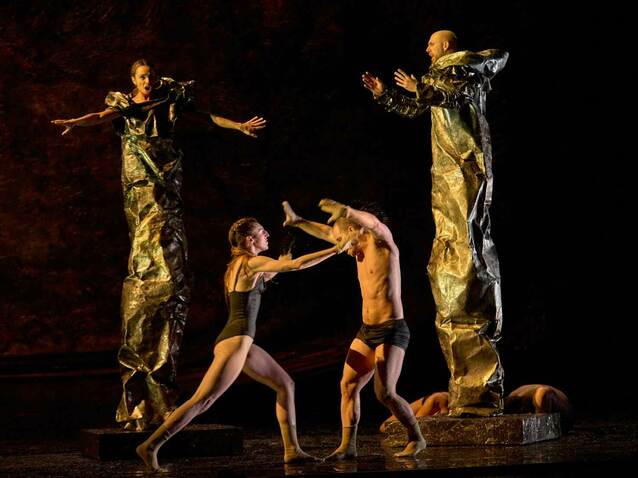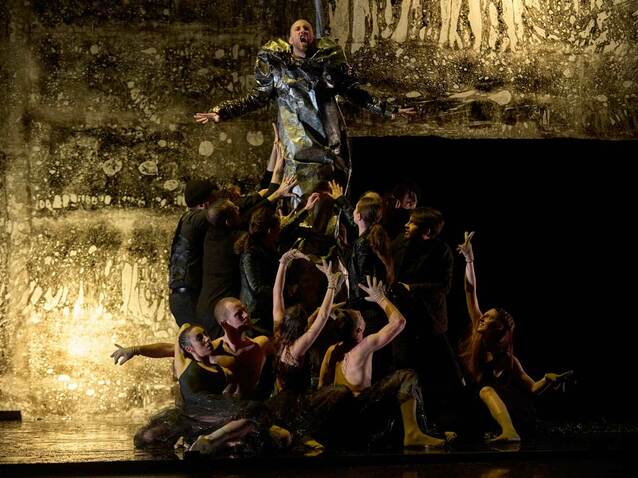 © Pablo Lorente / Liceu
© Pablo Lorente / Liceu
The raw material for the show, Henry Purcell's opera Dido & Aeneas, was of the highest quality. The ensemble Les Arts Florissants led by its founder, William Christie, a world reference in the field of Baroque music performance, guaranteed a good instrumental and choral performance. The vocal soloists also seemed adequate.
The intention was good: presenting Dido & Aeneas in a danced version seemed like a good idea, it has been done with this same title on other occasions with good results (the celebrated one by Sasha Waltz, for example) and the fact that the choreography and stage direction were by the experienced choreographer, dancer, filmmaker and actress Blanca Li, who had already worked with Christie on another occasion, seemed ideal.
The intention was good, the performers were adequate, there were no incidents, everyone performed to the high standard expected, and yet there is something about this show that doesn't quite work and prevents it from reaching the level of excellence.
To begin with, the fact that the opera was preceded by a performance of the ode "Celestial music did the gods inspire" was not at all appropriate, even though the piece is by Purcell himself, and it was clear that it was a tacked-on addition to make the performance not so short in duration.
Visually the production was small, it looked like a production conceived and executed for a stage smaller than the enormous stage of Liceu. The proposed version of the work surely gains in the intimacy of the short distance and this was not possible at Liceu. There was always plenty of empty space on one side or the other, and placing the small instrumental ensemble on the stage but totally foreshortened to one side made it seem even smaller.

Dido and Aeneas (c) Pablo Lorente / Liceu
Evi Keller’s set design plays a lot with light and its reflection, but the details of her work, which were surely there, were lost because the general lighting was poor. Everything was too dark and could not be seen well from the hall. Too bad.
The idea of placing the vocal soloists on a kind of pedestal where they were imprisoned for the duration of the piece, and which meant that they could only move if the pedestals were moved by the dancers, clearly seems to be the idea of a stage director who is also a choreographer and needs the whole stage for her dancers. It seemed as if the singers were in the way.
The stage space, covered by a thin film of water, worked ideally, the whole dance company gliding smoothly over the surface and producing moments and movements of great beauty, but the price paid for this was to turn the soloists into statues while their "doubles" danced on stage. Too high a price. As a dance performance it worked, as an opera it did not.
William Christie and Les Arts Florissants gave a performance of a high standard, but perhaps it was not necessary to caricature the witches' choirs so vocally. In the late 17th century people took witches very seriously.
The best musical moment, obviously, was achieved with the impressive "Dido's Lament". Kate Lindsey achieved - despite the pedestal - perfect singing, full of pain and sadness and the orchestra, for a moment, became magical.
Very well, too, Renato Dolcini who played Aeneas but who also had to sing the role of the sorceress. Another debatable idea.
Xavier Pujol
Barcelona, 20th June 2023
Dido & Aeneas by Henry Purcell. Kate Lindsey, mezzosoprano. Renato Dolcini, baritone. Ana Vieira Leite, soprano. Maud Gnidzaz, soprano. Virginie Thomas, soprano. Jacob Lawrence, tenor. Michael Loughlin Smith, tenor. Bastien Rimondi, tenor. Padraic Rowan, bass-baritone. Daniel Brant, tenor. Christophe Gautier, bass. Dancers of the Blanca Li Company. Choir and Orchestra Les Arts Florissants. William Christie, conductor. Blanca Li, stage direction and choreography. Evi Keller, scenography and sculpture-costumes of the solo singers. Laurent Mercier, costumes. Pascal Laajili, lighting. Co-production by Gran Teatre del Liceu, Teatros del Canal, Théâtre Impérial de Compiègne, Château de Versailles Spectacles and Les Arts Florissants.
the 23 of June, 2023 | Print
Comments